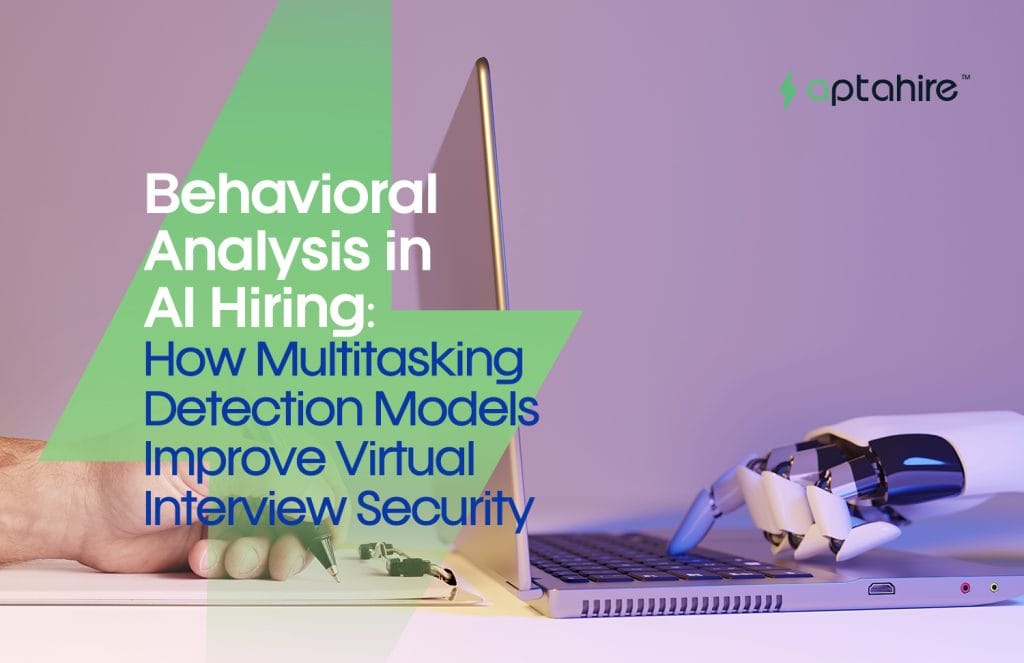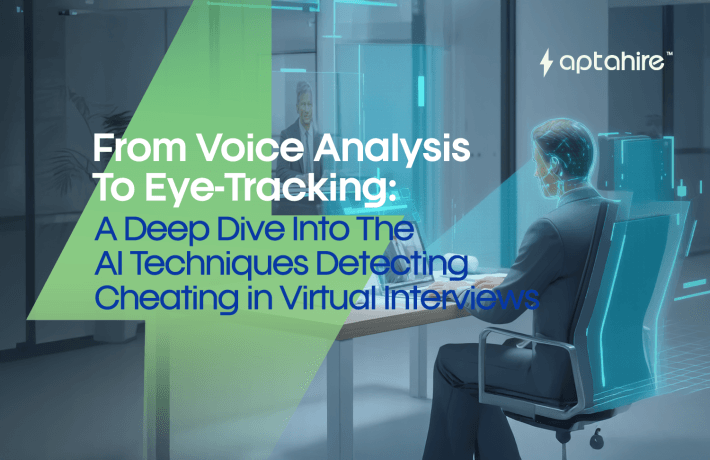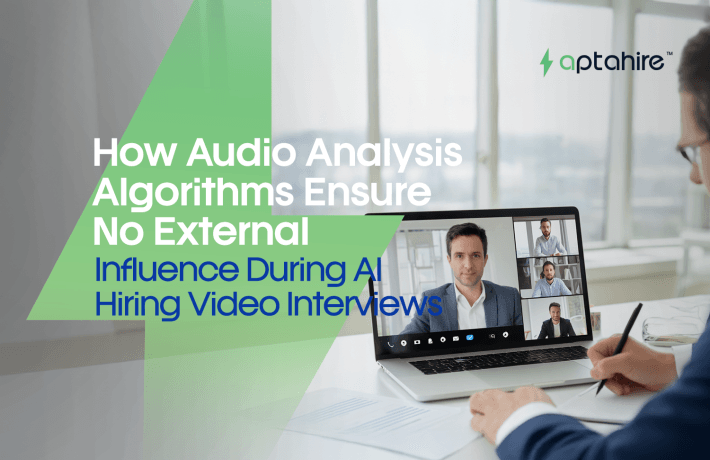Behavioral Analysis in AI Hiring: How Multitasking Detection Models Improve Virtual Interview Security

Introduction
In the world of virtual hiring, first impressions don’t just happen face-to-face anymore, they’re often pixel-to-pixel. As video interviews become the norm, hiring managers face a new challenge: how can they be sure a candidate is fully engaged, without external help, and genuinely focused on the conversation at hand?
This is where AI-powered behavioral analysis steps in, armed with one particularly sharp tool, multitasking detection models. Imagine an interviewer with superhuman observational skills who can instantly spot when someone’s attention drifts to another tab, when their eyes keep flicking off-screen, or when their hand movements hint at phone use. AI hiring platforms are now doing exactly that, offering recruiters the confidence that what they’re evaluating is the candidate’s true ability, not an assisted or distracted performance.
Beyond simply catching cheaters, this technology protects fairness in the hiring process. Every applicant gets the same level playing field, and companies can trust they’re making decisions based on genuine interactions. As we move toward a digital-first recruitment landscape, multitasking detection is becoming as essential as verifying a résumé, because focus speaks volumes about a person’s professionalism.
Why Multitasking in Virtual Interviews is a Problem
Multitasking during an interview can mean a few things:
- Googling answers while responding
- Chatting with someone in another tab for help
- Reading prepared scripts on another device
- Even toggling between interview and unrelated work
The problem?
It compromises authenticity, making it hard for recruiters to assess real skills, critical thinking, and cultural fit.
In industries where quick decision-making, integrity, and problem-solving are non-negotiable, this can be a serious red flag.
How AI Behavioral Analysis Works
Behavioral analysis in AI hiring tools goes beyond simple face detection.
It studies how a candidate interacts during the interview. Here’s what’s under the hood:
1. Eye Movement Tracking
AI tracks whether the candidate’s gaze consistently stays on the screen or frequently shifts to another device.
- Prolonged downward glances? Possibly reading from notes.
- Side glances? Could be checking another monitor.
2. Posture & Gesture Recognition
AI maps body posture and detects unusual leaning or repetitive off-screen movements that suggest divided attention.
3. Audio Pattern Monitoring
If there’s background chatter, faint whispers, or keyboard tapping, AI flags potential external assistance.
4. Window Focus & Activity Tracking
Some advanced AI systems monitor whether the interview window is the active one or if the candidate switches apps during the process.
The Role of Multitasking Detection Models
Multitasking detection models are specialized AI algorithms designed to flag suspicious behaviors in real-time.
Key Features:
- Micro-behavior pattern mapping – Tracks subtle cues that humans might miss.
- Contextual understanding – Distinguishes between natural breaks in eye contact (thinking) vs. suspicious repetitive movements.
- Real-time alerts – Notifies the interviewer or system when a candidate may be multitasking.
- Scoring authenticity – Generates a credibility score for each interview, helping recruiters prioritize genuine candidates.
Why This Improves Virtual Interview Security
Virtual hiring has vulnerabilities, no physical control over environment, no ability to see what’s outside the frame.
Multitasking detection:
- Prevents unfair advantage from external help
- Builds trust in the recruitment process
- Reduces risk of bad hires caused by misrepresented skills
- Ensures compliance in regulated industries (finance, healthcare, etc.)
Real-World Example
A global software firm noticed that nearly 18% of its virtual interview candidates were getting unusually high technical assessment scores, despite weaker résumés.
After implementing AI multitasking detection:
- They identified instances where candidates used messaging apps for live answers.
- Post-implementation, the accuracy of skill assessments improved by 34%.
- Recruiter confidence in remote hiring decisions grew significantly.
Striking the Balance: Security Without Feeling “Creepy”
While AI offers robust security, companies must:
- Be transparent: Inform candidates about AI-powered monitoring before the interview.
- Focus on ethics: Use the data solely for hiring purposes.
- Ensure privacy: Store and process only necessary behavioral data.
This creates a fair, respectful, and trust-based hiring environment, for both candidates and recruiters.
The Future of Behavioral AI in Hiring
Looking ahead, multitasking detection will likely integrate with:
- Cognitive load measurement – Understanding mental effort during problem-solving.
- Adaptive questioning – Changing questions on the fly based on candidate behavior.
- Cross-device monitoring – Identifying use of secondary devices during the interview.
In short, AI hiring won’t just ask “What’s your answer?”, it will understand how you arrived at it.
Final Thoughts
The modern job interview has evolved far beyond handshakes and conference rooms. Today, it’s about creating a secure, fair, and distraction-free digital space where talent can shine without external interference. Multitasking detection models, powered by advanced AI behavioral analysis, are not just a “nice-to-have” tool, they are becoming the gold standard for virtual interview integrity.
By identifying shifts in attention, unusual screen activity, or subtle cues of divided focus, these systems help recruiters uncover a more accurate picture of each candidate. This doesn’t just protect employers from poor hiring decisions, it protects honest candidates from being outcompeted by those cutting corners.
In an era where trust and transparency are everything, multitasking detection ensures that hiring remains about what truly matters: skills, potential, and authenticity. The future of recruitment isn’t just about finding the right people, it’s about finding them in the right way. And with AI keeping a watchful, unbiased eye, that future looks brighter (and much more focused) than ever.
FAQs
1. What is multitasking detection in AI hiring?
Multitasking detection is an AI-driven feature that identifies when a candidate is attempting to focus on multiple activities during a virtual interview, such as browsing the internet, messaging others, or referring to unauthorized notes, thereby ensuring fair and distraction-free assessments.
2. Why is multitasking detection important in virtual interviews?
It helps maintain interview integrity by ensuring candidates are focused solely on the interview questions and not seeking external help, which gives employers a more accurate understanding of their skills and abilities.
3. How does AI detect multitasking in virtual interviews?
AI uses behavioral analysis, such as eye movement tracking, facial focus patterns, keystroke activity, and background noise monitoring, to identify when a candidate’s attention shifts away from the interview.
4. Does multitasking detection invade a candidate’s privacy?
No. Reputable AI hiring platforms use ethical and compliant methods, tracking only relevant behavioral patterns without accessing private information or personal files.
5. What happens if a candidate is flagged for multitasking?
The system alerts the recruiter with time-stamped instances, allowing them to review the evidence and make an informed decision rather than automatically disqualifying the candidate.
6. Can multitasking detection reduce cheating in virtual hiring?
Yes. By detecting unauthorized activities during interviews, multitasking detection significantly reduces the chances of candidates receiving external assistance or using pre-written answers.
7. Is multitasking detection AI biased?
High-quality AI platforms are trained on diverse datasets to minimize bias and focus solely on behavioral cues, not personal characteristics such as gender, race, or accent.
8. How does this technology improve hiring efficiency?
It saves recruiters from lengthy manual verification, ensures fairness across all candidates, and helps shortlist truly capable talent faster.
9. Is multitasking detection suitable for all industries?
Yes. Whether it’s tech, healthcare, finance, education, or creative industries, multitasking detection can ensure integrity in any role requiring skill-based interviews.
10. Can multitasking detection work alongside other AI hiring tools?
Absolutely. It integrates seamlessly with other AI hiring features such as speech analysis, skill testing, and background verification for a comprehensive recruitment process.



